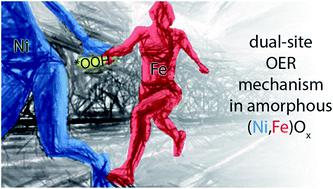当前位置:
X-MOL 学术
›
J. Mater. Chem. A
›
论文详情
Our official English website, www.x-mol.net, welcomes your
feedback! (Note: you will need to create a separate account there.)
Local structural changes in polyamorphous (Ni,Fe)Ox electrocatalysts suggest a dual-site oxygen evolution reaction mechanism
Journal of Materials Chemistry A ( IF 10.7 ) Pub Date : 2021-5-19 , DOI: 10.1039/d1ta02104d Martin A. W. Schoen 1, 2, 3, 4 , Oliver Calderon 1, 2, 3, 4 , Nicholas M. Randell 1, 2, 3, 4 , Santiago Jimenez-Villegas 1, 2, 3, 4 , Katelynn M. Daly 1, 2, 3, 4 , Roman Chernikov 4, 5, 6, 7 , Simon Trudel 1, 2, 3, 4
Journal of Materials Chemistry A ( IF 10.7 ) Pub Date : 2021-5-19 , DOI: 10.1039/d1ta02104d Martin A. W. Schoen 1, 2, 3, 4 , Oliver Calderon 1, 2, 3, 4 , Nicholas M. Randell 1, 2, 3, 4 , Santiago Jimenez-Villegas 1, 2, 3, 4 , Katelynn M. Daly 1, 2, 3, 4 , Roman Chernikov 4, 5, 6, 7 , Simon Trudel 1, 2, 3, 4
Affiliation

|
Amorphous nickel–iron mixed metal oxides have been shown to be extremely efficient oxygen evolution reaction (OER) electrocatalysts with good stability in alkaline reaction conditions. Thus, they offer an economical alternative to expensive conventional platinum- or iridium-based OER catalysts and could provide a crucial step towards a hydrogen-based energy economy. These favorable properties are presumably due to a synergistic effect between Fe and Ni. However, these synergistic effects strongly depend on the local structure of the catalyst and their origin – and its relation to the local structure – are still not fully understood. In this work we present a study of the thermal annealing induced structural evolution of amorphous (Ni,Fe)Ox thin films, and correlate this evolution to their OER catalytic capabilities. Samples are X-ray amorphous at low annealing temperatures. However, analysis of the X-ray absorption spectra reveals local structural transitions in all samples – before the onset of crystallization – providing evidence of polyamorphism. Transitions of the local Ni and Fe environments occur at distinctly different temperatures and coincide with a stepwise increase in the catalytic activation potential (OER thermodynamics) and the Tafel slope (OER kinetics), respectively. We previously have attributed the increase in onset potential to a change in active site in NiOx at the phase transition temperature; considering that the mixed metal oxides' onset potentials exhibit the same behavior with annealing temperature (Tanneal), we conclude that the potential-determining OER reaction step must occur at a Ni site. Similarly, the reaction kinetics change at the same annealing temperature as the local Fe environment; we thus infer that the rate-determining step occurs at a Fe site. To reconcile these observations we put forward a dual-site OER reaction mechanism with potential- and rate-determining steps happening at Ni and Fe sites, respectively. This synergistic effect is ultimately responsible for the superior OER performance of many (Ni,Fe)Ox catalysts. At higher annealing temperatures, the synergistic effect is suppressed, possibly by phase separation into NiOx and FeOx phases, as suggested by our X-ray diffraction results.
中文翻译:

多非晶(Ni,Fe)Ox 电催化剂的局部结构变化表明双中心析氧反应机制
非晶镍铁混合金属氧化物已被证明是极其有效的析氧反应 (OER) 电催化剂,在碱性反应条件下具有良好的稳定性。因此,它们为昂贵的常规铂基或铱基OER催化剂提供了一种经济的替代方法,并且可能为迈向氢基能源经济迈出了关键的一步。这些有利的特性可能是由于 Fe 和 Ni 之间的协同效应。然而,这些协同效应在很大程度上取决于催化剂的局部结构和它们的来源——以及它与局部结构的关系——仍然没有被完全理解。在这项工作中,我们对热退火引起的非晶态(Ni,Fe)O x的结构演化进行了研究。薄膜,并将这种演变与它们的 OER 催化能力相关联。样品在低退火温度下是 X 射线无定形的。然而,对 X 射线吸收光谱的分析揭示了所有样品中的局部结构转变——在结晶开始之前——提供了多晶型的证据。局部 Ni 和 Fe 环境的转变发生在明显不同的温度下,并且分别与催化活化电位(OER 热力学)和 Tafel 斜率(OER 动力学)的逐步增加相吻合。我们之前已经将起始电位的增加归因于相变温度下NiO x中活性位点的变化;考虑到混合金属氧化物的起始电位表现出与退火温度相同的行为(T退火),我们得出结论,决定电位的 OER 反应步骤必须发生在 Ni 位点。同样,反应动力学在与局部 Fe 环境相同的退火温度下发生变化;因此我们推断速率决定步骤发生在 Fe 位点。为了调和这些观察结果,我们提出了双位点 OER 反应机制,分别在 Ni 和 Fe 位点发生电位和速率决定步骤。这种协同效应最终导致许多 (Ni,Fe)O x催化剂具有优异的 OER 性能。正如我们的 X 射线衍射结果所表明的那样,在更高的退火温度下,协同效应被抑制,这可能是由于相分离为 NiO x和 FeO x相。
更新日期:2021-05-28
中文翻译:

多非晶(Ni,Fe)Ox 电催化剂的局部结构变化表明双中心析氧反应机制
非晶镍铁混合金属氧化物已被证明是极其有效的析氧反应 (OER) 电催化剂,在碱性反应条件下具有良好的稳定性。因此,它们为昂贵的常规铂基或铱基OER催化剂提供了一种经济的替代方法,并且可能为迈向氢基能源经济迈出了关键的一步。这些有利的特性可能是由于 Fe 和 Ni 之间的协同效应。然而,这些协同效应在很大程度上取决于催化剂的局部结构和它们的来源——以及它与局部结构的关系——仍然没有被完全理解。在这项工作中,我们对热退火引起的非晶态(Ni,Fe)O x的结构演化进行了研究。薄膜,并将这种演变与它们的 OER 催化能力相关联。样品在低退火温度下是 X 射线无定形的。然而,对 X 射线吸收光谱的分析揭示了所有样品中的局部结构转变——在结晶开始之前——提供了多晶型的证据。局部 Ni 和 Fe 环境的转变发生在明显不同的温度下,并且分别与催化活化电位(OER 热力学)和 Tafel 斜率(OER 动力学)的逐步增加相吻合。我们之前已经将起始电位的增加归因于相变温度下NiO x中活性位点的变化;考虑到混合金属氧化物的起始电位表现出与退火温度相同的行为(T退火),我们得出结论,决定电位的 OER 反应步骤必须发生在 Ni 位点。同样,反应动力学在与局部 Fe 环境相同的退火温度下发生变化;因此我们推断速率决定步骤发生在 Fe 位点。为了调和这些观察结果,我们提出了双位点 OER 反应机制,分别在 Ni 和 Fe 位点发生电位和速率决定步骤。这种协同效应最终导致许多 (Ni,Fe)O x催化剂具有优异的 OER 性能。正如我们的 X 射线衍射结果所表明的那样,在更高的退火温度下,协同效应被抑制,这可能是由于相分离为 NiO x和 FeO x相。















































 京公网安备 11010802027423号
京公网安备 11010802027423号